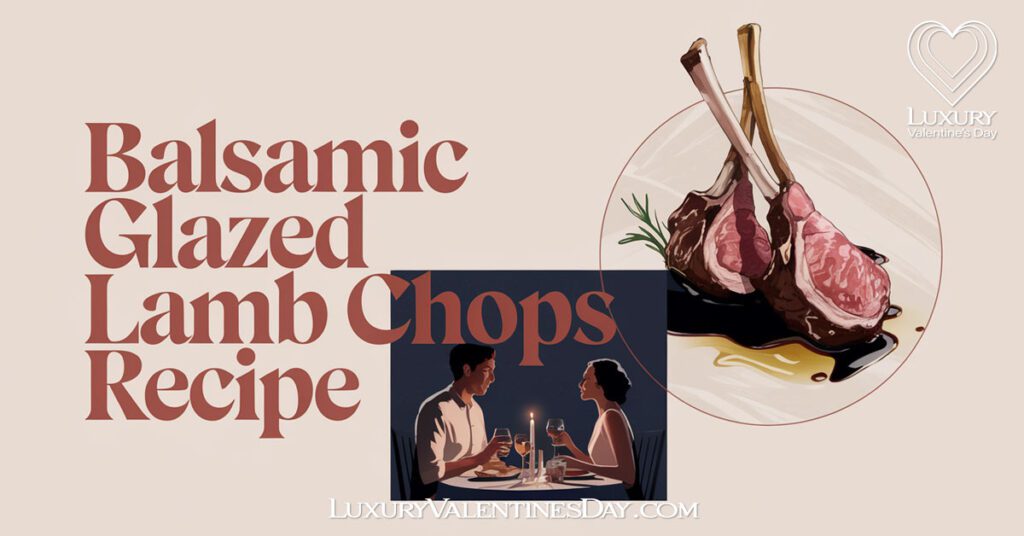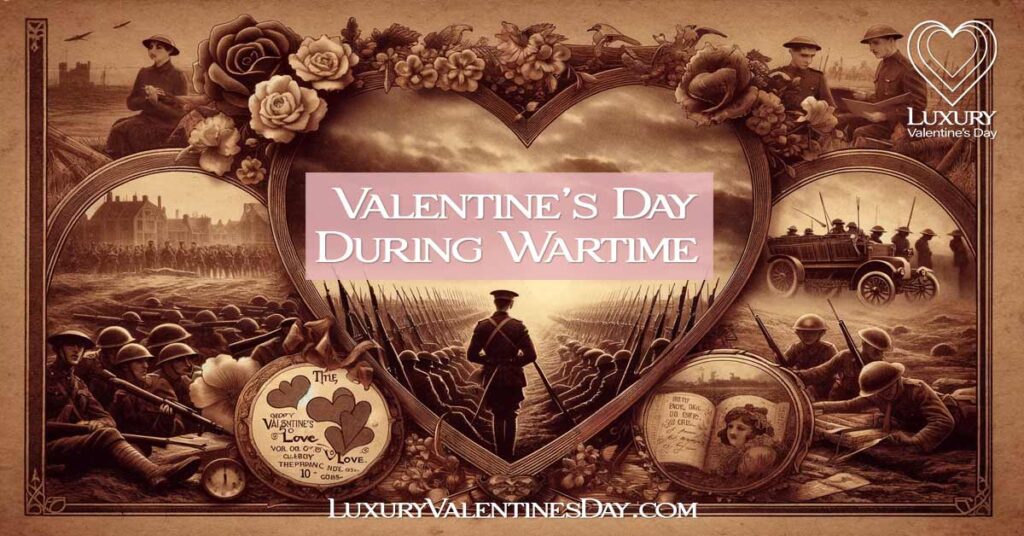
Table of Contents
ToggleThe Heartbeat of Love Amidst the Echoes of War
Imagine a world where the echoes of war drums blend with the whispers of love. That’s the untold narrative of Valentine’s Day during wartime, a tale of enduring affection amidst the ravages of conflict. This article isn’t just a history lesson; it’s a journey through time, revealing how love letters and heartfelt tokens kept the flame of love alive, even when the world seemed dark. As we explore the impact of wars, from the American Civil War to World War II, on Valentine’s Day celebrations, we uncover stories of hope, resilience, and the unyielding power of love.
Key Takeaways
- Heartfelt Correspondence: Discover the pivotal role of letters and postcards as lifelines of love during wars, offering a unique glimpse into the personal lives of those separated by battle.
- Changing Traditions: Witness how Valentine’s Day celebrations evolved through different war periods, adapting to the constraints and emotions of the times.
- Symbols of Hope: Learn how Valentine’s Day became a beacon of hope, offering solace and connection in an otherwise bleak landscape.
- Enduring Love Stories: Unearth touching accounts of couples who defied the odds, maintaining their bonds through the turmoil of war.
- Historical Insights: Gain a deeper understanding of how these turbulent periods influenced personal expressions of love and the significance of Valentine’s Day.
Love Amidst the Cannon’s Roar: The American Civil War

The American Civil War, a period marked by division and conflict, surprisingly also played host to expressions of deep affection and longing, especially around Valentine’s Day. It’s a chapter of history where the fragility of human emotions intersected with the harsh realities of war.
Emotional Lifelines Through Letters
In the midst of the American Civil War’s chaos, a different kind of battle was being fought – one of love and connection. This section isn’t just about war; it’s a heart-touching chronicle of how soldiers and their loved ones clung to the written word to keep their relationships alive.
During this era, when lovers were miles apart, letters served as their sole comfort. The scarcity of resources and the uncertainty of war turned these letters into priceless treasures. Handwritten on whatever scraps of paper could be found, these missives often bore the smudges of campfires and the urgency of hearts yearning for reunion. They were more than just letters; they were lifelines, sustaining love across the battle-torn landscape.
Men in uniform poured their fears, hopes, and undying affection into these letters. Many of these correspondences were adorned with simple, yet heartfelt, hand-drawn illustrations – flowers, hearts, and sometimes patriotic symbols, reflecting both their love and their loyalty to the cause.
On the home front, women eagerly awaited these letters. They would often craft handmade valentines, intricate and delicate, sending them as tokens of their enduring love and patience. These valentines were not just expressions of romance but also of support, reminding their men that there was something beautiful worth fighting for.
Handcrafted Tokens of Love
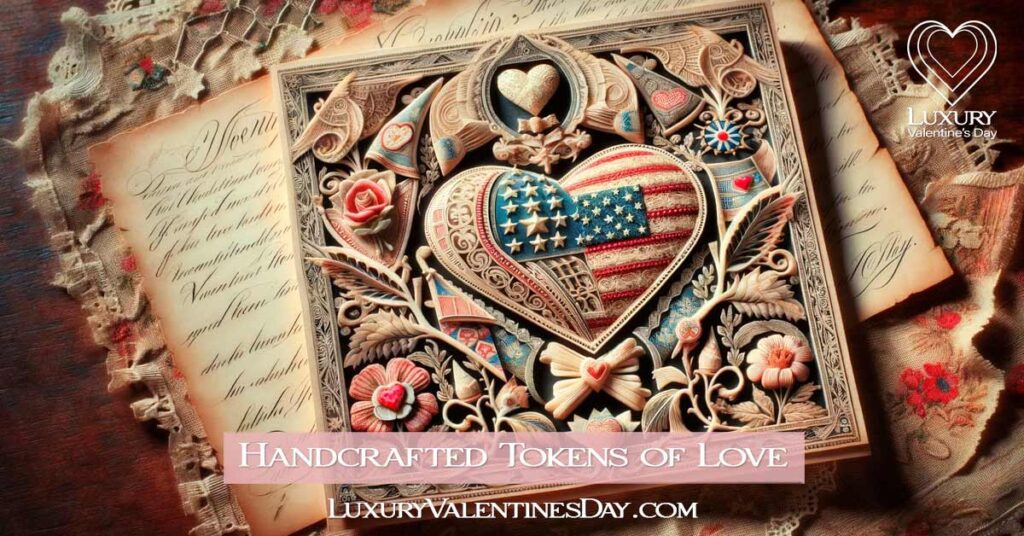
During the Civil War, Valentine’s Day saw a fascinating blend of creativity and emotion manifest in the form of handcrafted valentines. These tokens, often made under constrained circumstances, were rich in personal significance and varied in tone and style.
- Diverse Range of Valentines: The war didn’t just bring sorrow; it also inspired a unique artistry in Valentine’s creations. Some were sweet and romantic, adorned with traditional symbols of love like hearts and flowers, reflecting the tender sentiments of those separated by war. Others took a more humorous or satirical turn, known as ‘vinegar valentines,’ offering a lighter perspective amid the grim realities of the time.
- Vinegar Valentines: As detailed in Emerging Civil War [1], these vinegar valentines often contained witty, sometimes sarcastic messages. Contrasting the conventional sweet notes, they served as a commentary on the complexities of relationships during wartime, reflecting the multifaceted emotions people experienced.
- Reflecting the Era’s Sentiments: These handcrafted valentines weren’t mere expressions of personal affection; they were imbued with the era’s essence. The intricacy and creativity in their design and the depth of their messages echoed the resilience and adaptability of a society torn by war yet clinging to the norms of love and affection.
In crafting these valentines, people of the Civil War era found a way to express their emotions, be it longing, love, or even humor, providing a nuanced glimpse into how Valentine’s Day was a beacon of normalcy and emotional expression during one of the most turbulent times in American history.
A Reflection of the Times
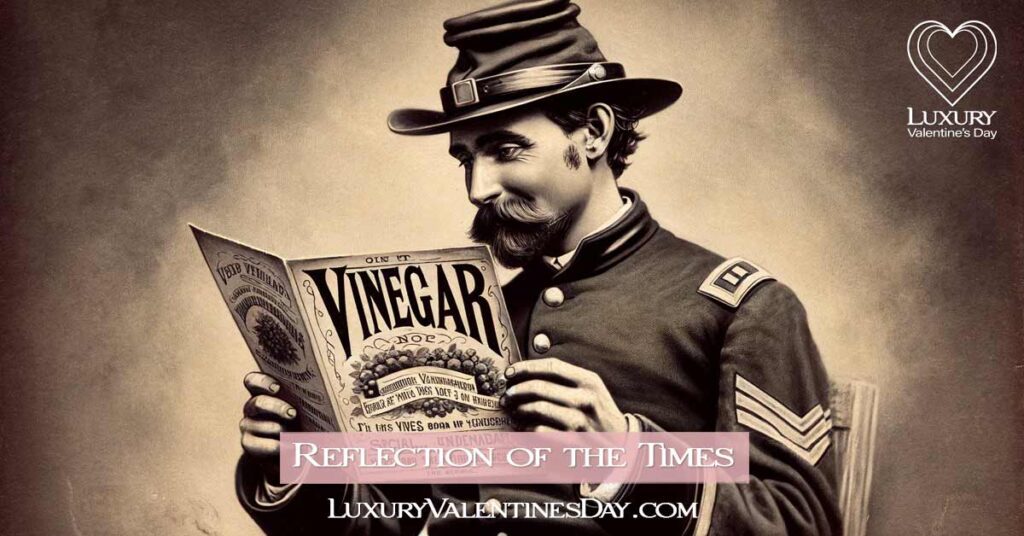
The valentines of the Civil War era were more than mere tokens of affection; they were mirrors reflecting the complexities and sentiments of a nation in turmoil. Their designs and messages often intertwined personal emotions with the broader social and political landscape of the time.
- Political and Social Commentary: As explored in the Journal of the Civil War Era [2], many valentines carried messages and imagery that subtly commented on the political and social issues of the era. These ranged from depictions of unity and division to subtler nods to the war’s causes and consequences.
- Satirical and Humorous Elements: Echoing this sentiment, Slate [3] highlights the prevalence of satire in Civil War valentines. These pieces often used humor as a coping mechanism, allowing individuals to express their views on the war and its impact on society in a manner that was both poignant and light-hearted.
- The Role of Valentine’s Day: This era’s valentines serve as a testament to how Valentine’s Day evolved from a purely romantic occasion to a platform for expressing a range of emotions and viewpoints. They reflected the complexities of life during the war, encapsulating love, longing, political opinions, and even societal critiques.
The valentines of the Civil War thus stand as historical artifacts that offer a unique window into the personal lives and societal undercurrents of the time. They reveal how people used Valentine’s Day not just to affirm their love but also to engage with the broader narrative of their era, making it a day that resonated with the multi-faceted experiences of a nation at war.
Enduring Love in Times of Turmoil

In the shadow of the Civil War’s upheaval, Valentine’s Day stood as a poignant symbol of enduring love and normalcy. This section delves into how, despite the chaos and separation brought by war, the tradition of sending valentines flourished, reflecting the resilience of love in the face of adversity.
- Persistence of Valentine Traditions: During the Civil War, the practice of sending valentines became a cherished ritual. As described in HistoryNet [4], these tokens of affection were not mere frivolities; they were vital expressions of love and hope. They served as reminders of the normalcy and beauty that existed beyond the battlefield, offering both soldiers and their loved ones a much-needed emotional reprieve.
- Innovative Expressions of Love: The Kansas Historical Society (KSHS) [5] highlights the innovative ways people expressed their love during these trying times. Limited resources led to the creation of unique, handcrafted valentines, often made from whatever materials were at hand. These valentines were symbols of not just love but also ingenuity and the human spirit’s tenacity.
- Love as a Source of Strength: Amid the uncertainties and hardships of war, these valentines played a crucial role in maintaining emotional bonds. They were a source of strength and motivation for both those fighting and those waiting at home, underscoring the belief that love could endure even the harshest of times.
- Historical Significance of Civil War Valentines: The valentines from this period are not just historical artifacts; they are poignant reminders of the human capacity for love and resilience. They tell stories of couples who braved separation and uncertainty, holding onto the hope of reunion and peace.
This section of the article paints a vivid picture of how, even during one of the most tumultuous periods in American history, Valentine’s Day remained a significant and powerful reminder of the enduring nature of love. It’s a narrative that weaves together the personal with the historical, offering readers a glimpse into the emotional strength that carried many through the trials of the Civil War.
Whispers of the Heart: Real Love Letters from the Civil War
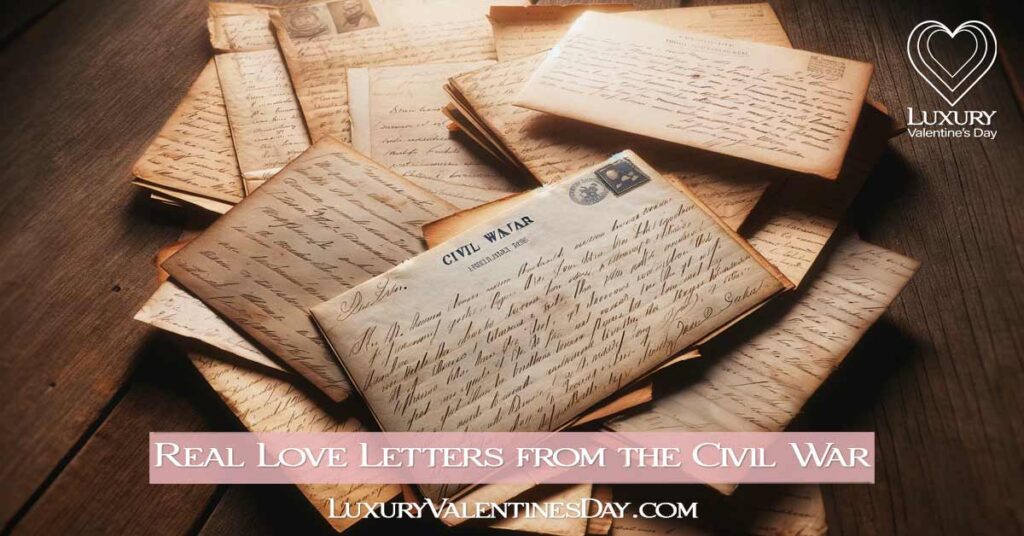
In these letters, the raw emotions and unwavering bonds of love amidst the harsh realities of war are vividly captured. They offer a deeply personal insight into the lives and hearts of those who lived through one of the most challenging periods in American history.
Sullivan Ballou’s Letter to His Wife, Sarah:
Perhaps one of the most famous Civil War letters, written by Major Sullivan Ballou to his wife Sarah just a week before he was killed at the First Battle of Bull Run. He wrote:
“My very dear Sarah… The indications are very strong that we shall move in a few days—perhaps tomorrow. And lest I should not be able to write you again, I feel impelled to write a few lines that may fall under your eye when I am no more… I have no misgivings about, or lack of confidence in the cause in which I am engaged, and my courage does not halt or falter. I know how American civilization now leans upon the triumph of the Government and how great a debt we owe to those who went before us through the blood and suffering of the Revolution. And I am willing—perfectly willing—to lay down all my joys in this life, to help maintain this Government, and to pay that debt… Sarah my love for you is deathless, it seems to bind me with mighty cables that nothing but Omnipotence could break; and yet my love of Country comes over me like a strong wind and bears me irresistibly with all those chains to the battlefield.”
A Letter from a Soldier Named James to His Mother:
“Dear Mother, This is my first chance to write you since the fight at [location]. Our regiment was in the forefront and we lost heavily. I am unharmed but the scenes of battle are imprinted in my mind. I think of home often and hope for the day when I can return to the family. Your son, James.”
A Confederate Soldier to His Wife, Margaret:
“My Dearest Margaret, I write to you in a moment’s calm amidst the ceaseless roar of cannon fire. My heart aches for the sight of you and our children. Every day I carry the small photograph of you in my pocket, a reminder of why I fight. Though we are apart, my love for you remains my guiding star. Yours forever, John.”
These letters provide a small window into the emotional world of soldiers and their loved ones during the American Civil War. They are expressions of love, hope, and the profound human connections that endured despite the chaos of war.
Valentine’s Day During World War 1: The Era of Postcards
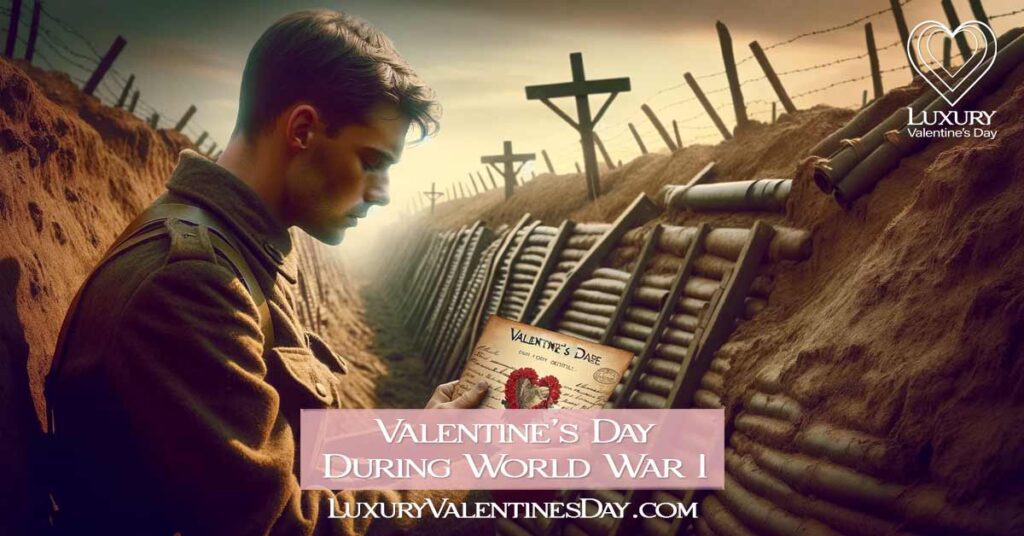
World War I brought about significant changes in the way Valentine’s Day was celebrated, particularly in the form of communication between loved ones. The widespread use of postcards during this era marked a distinct shift in Valentine’s expressions.
The Rise of Postcards as Communication
During World War I, postcards emerged as a prominent form of communication, especially significant during Valentine’s Day. This shift was both a necessity of war and a reflection of the changing times. Postcards offered a practical and efficient way for soldiers entrenched in distant battlefields to connect with their loved ones back home. Their ease of use, coupled with the relatively straightforward postal services available in war zones, made them an ideal choice for soldiers.
In the midst of the conflict, these postcards became more than mere pieces of paper; they were lifelines, carrying messages of love, hope, and reassurance across dangerous miles. A soldier could quickly jot down a few lines of affection, perhaps in the brief respite between battles, and send it off with the hope that it would bring a moment of joy to his beloved. The University of Sydney’s [6] account of a Valentine’s Day letter from 1917 vividly illustrates this practice. It wasn’t uncommon for a soldier to share glimpses of his life at the front, painting a picture of his world for someone miles away.
But these postcards were not just one-sided conversations. They also allowed those on the home front, particularly women, to express their feelings, offer words of encouragement, and maintain a connection with their absent sweethearts. This exchange of postcards became a ritual of sorts, a small but significant act that kept the flame of relationships burning despite the war’s darkness.
Moreover, the content of these postcards often went beyond mere personal messages. Many featured patriotic designs or romantic illustrations, symbolizing the intertwined nature of love and duty. They were a testament to the era’s spirit, where expressing love and supporting the war effort often went hand in hand.
Thus, the rise of postcards during World War I marked a poignant chapter in the history of Valentine’s Day. It was an era where the simplicity of a postcard carried immense emotional weight, embodying the resilience of love in the face of global upheaval.
Changing Nature of Valentine’s Expressions

The First World War significantly transformed the way Valentine’s Day was celebrated, reshaping it from a day typically marked by grand romantic gestures to one defined by more understated, yet deeply meaningful, expressions of love. This shift was a direct response to the realities of the war, which imposed physical separation and brought about a heightened sense of emotional longing.
The lavish and elaborate celebrations of love common in the pre-war era gave way to simpler forms of expression. With many men away at the front and resources more limited, the traditional fanfare and extravagance associated with Valentine’s Day were no longer feasible. Instead, people found new, heartfelt ways to express their affection, largely through the medium of postcards, as ITV News [7] illustrates with examples of passion and longing expressed in brief but poignant messages from WWI troops.
These postcards, often decorated with patriotic emblems or romantic imagery, served as a new canvas for expressions of love. They became a symbol of the era, embodying a blend of romantic sentiment and a sense of duty to the nation. The imagery and words chosen for these postcards reflected the temper of the times – a combination of love, longing, and a deep sense of commitment to the cause.
Furthermore, this change in Valentine’s Day expressions was not just about adapting to the limitations imposed by war. It was also about maintaining a sense of normalcy and continuity in a world turned upside down by conflict. The act of sending a simple postcard became a powerful gesture of love and resilience, a way to bridge the gap between the home front and the battlefield.
The evolution of Valentine’s Day during World War I from grandeur to simplicity highlights the adaptability of human expression. It shows how, even in times of great adversity, people find ways to celebrate love and keep the spirit of Valentine’s Day alive. This period in history stands as a poignant reminder of the enduring nature of love, even in the midst of global upheaval.
Valentine Volunteers and Love Stories
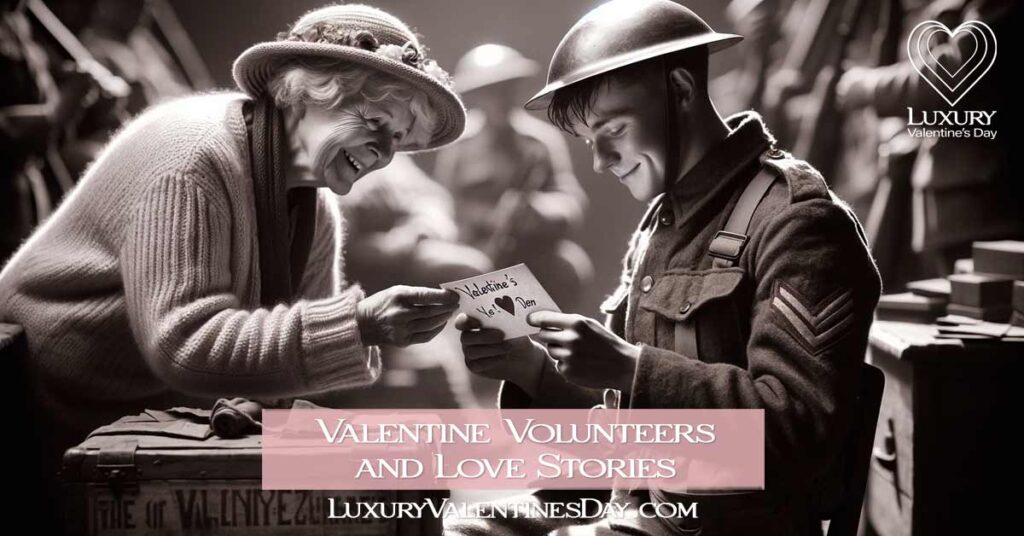
The role of volunteer organizations like the Red Cross, during the conflict of The Great War, became crucial in maintaining the emotional bonds between soldiers at the front and their loved ones back home. These organizations acted as the vital link in the chain of love and communication, ensuring that the sentiments expressed in postcards and letters reached their intended recipients.
Volunteers, many of whom were women, dedicated countless hours to facilitating this flow of correspondence. They played an integral role in what can be described as a massive, global effort to keep the flames of love burning across continents. Their work often involved sorting, delivering, and sometimes even reading out letters to wounded soldiers, acting as a bridge between separated hearts.
The stories that unfolded through these exchanges were both poignant and profound. The Red Cross UK’s account [8] of Valentine’s Day during WWI highlights the dedication of these volunteers, who not only ensured the delivery of messages but also bore witness to the love stories that blossomed even in the darkest of times. These tales were varied – some spoke of new love sparked through words on a postcard, while others told of enduring love sustained over years of separation.
The volunteer effort during this time was more than just a logistical feat; it was a testament to the power of human connection. In a world torn apart by conflict, these volunteers helped to preserve the human elements of love, hope, and compassion. They were the unsung heroes of Valentine’s Day, playing a crucial role in keeping the spirit of the day alive, despite the war.
These love stories and the role of volunteers in World War I offer a unique perspective on Valentine’s Day. They show how the day of love adapted to the circumstances of the time, becoming not just a celebration of romantic love, but also a celebration of the enduring human spirit, capable of overcoming even the greatest of challenges.
Impact of Postcards on Relationships
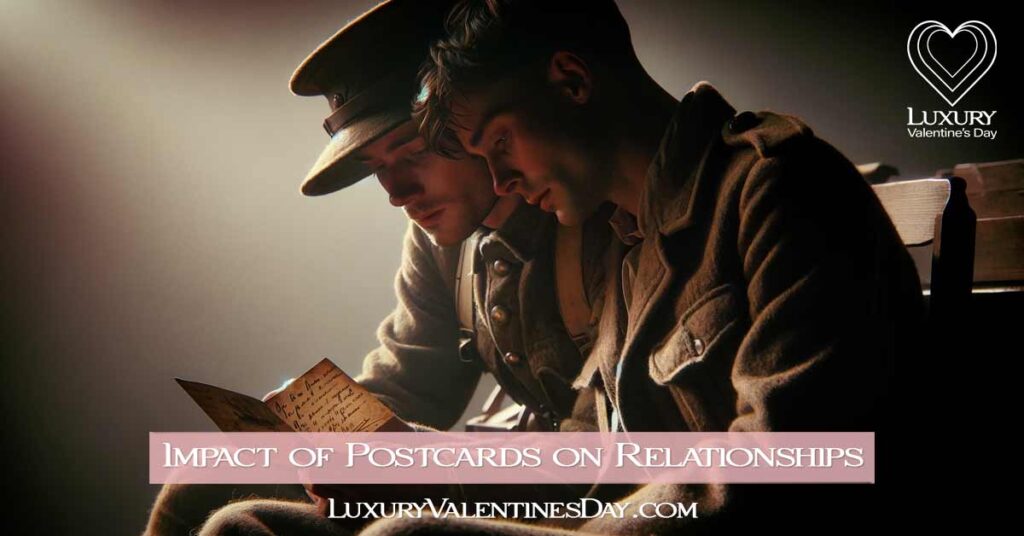
The impact of postcards on relationships during World War I extended far beyond their physical form as small, paper rectangles sent across miles. These postcards became emblematic of the resilience of human connections in an era marked by separation and uncertainty. They were more than just a means of communication; they were a symbol of enduring love and hope.
The brief messages scribbled on these postcards held immense emotional significance. For many soldiers, writing a postcard was a rare opportunity to escape the grim realities of war, if only for a moment, and reconnect with their loved ones. Each word was chosen with care, encapsulating feelings of longing, love, and sometimes the pain of separation. Steemit’s [9] exploration of Valentine’s Day during the First World War highlights how these small pieces of paper became cherished tokens, eagerly awaited by those on the home front.
For the recipients, these postcards were tangible reminders that their loved ones were still thinking of them, still caring for them, even in the midst of chaos. The National Army Museum’s [10] collection of WWI love letters and postcards illustrates this beautifully, showcasing the depth of emotion and the strength of bonds maintained through these brief, written exchanges.
Moreover, the postcards served as a lifeline for relationships, fostering a sense of normalcy and continuity amidst the upheaval of war. They were a source of comfort, a beacon of hope, and often the only link between separated lovers. The anticipation of receiving a postcard, followed by the joy of reading it, kept many relationships alive and thriving, despite the physical distance.
The postcards of World War I thus had a profound impact on relationships. They bridged the gap between the home front and the battlefields, carrying messages of love and hope across borders and through the barriers of war. In this way, they played an invaluable role in maintaining the emotional well-being of both the senders and receivers, proving that even in the darkest times, the human connection remains a powerful force.
Valentine’s Day During World War II: Love Beyond Borders and The Role of International Communication
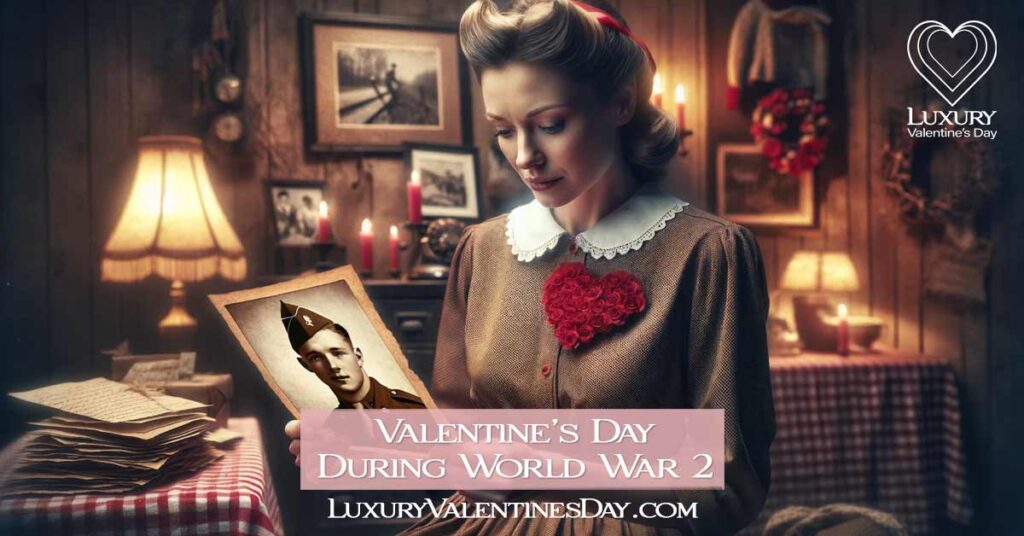
World War II, with its global scale, brought new challenges and dynamics to the celebration of Valentine’s Day. The conflict spanned continents, separating loved ones not just by miles but by oceans. In this context, international communication became a critical lifeline, connecting individuals across vast distances.
During this time, the exchange of letters and messages took on an even greater significance. With advancements in international postal services, despite the disruptions caused by the war, letters became the primary means of maintaining relationships. These written exchanges were more than just words; they were a precious link, a way for people to share their experiences, fears, hopes, and, most importantly, their love.
The Bombing of Prague and Love in Turmoil
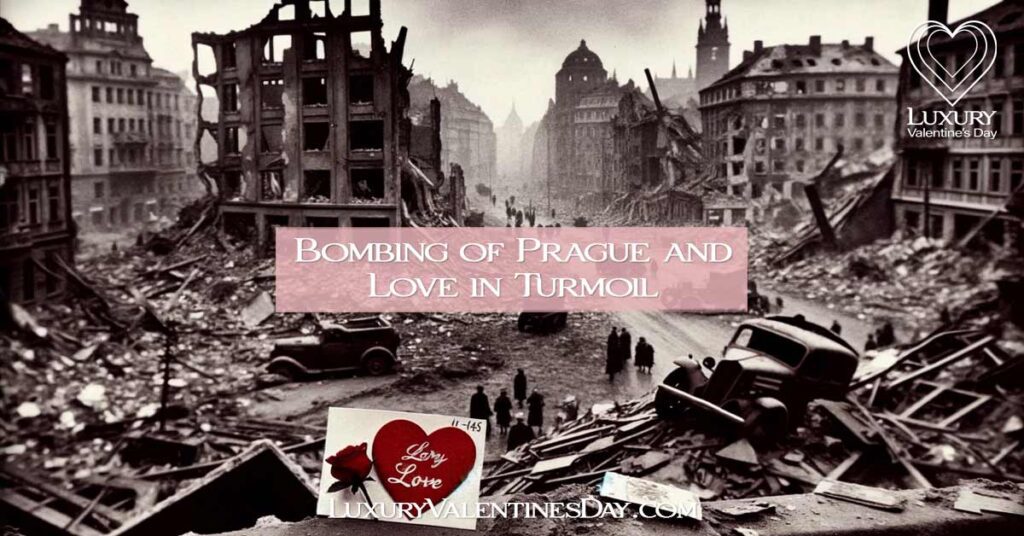
One poignant event that illustrates the power of love amidst the chaos of war was the bombing of Prague on February 14, 1945 [11]. This tragic incident, caused by the United States Army Air Forces (USAF), occurred on Valentine’s Day, a day traditionally associated with love and affection. It highlighted the stark contrast between the celebration of love and the realities of war. Amidst this turmoil, the resilience of love stood out. Couples found ways to express their affection, even under the shadow of such devastating events. Love letters and Valentine’s messages became symbols of hope and resistance against the backdrop of conflict.
Stories of Couples United Through Messages
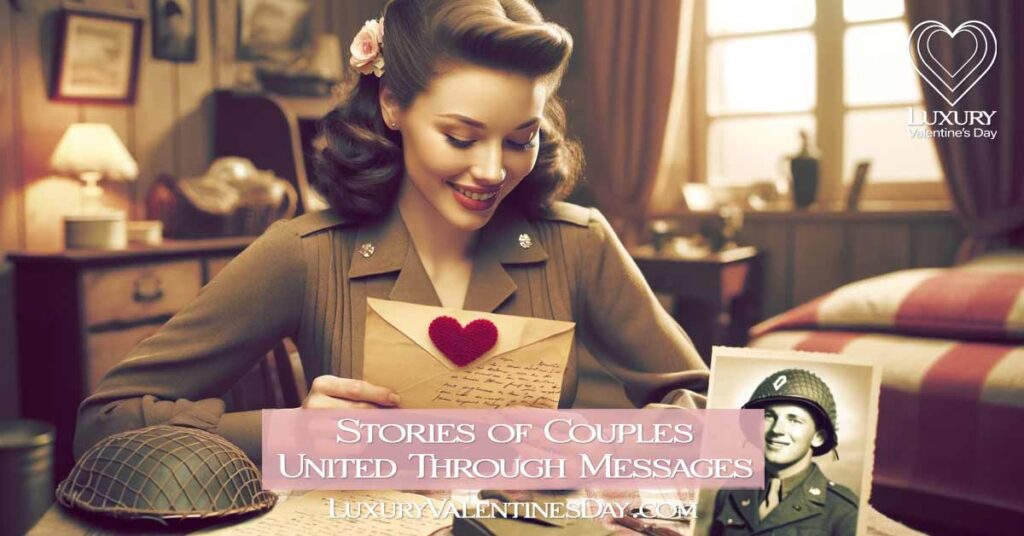
The stories of couples who were kept apart by the war, yet remained united through their Valentine’s messages, are both heart-wrenching and inspiring. The National WWII Museum [12] provides insights into such narratives. One example is the correspondence between a soldier stationed overseas and his wife back home. Their letters, filled with longing and affection, are a testament to the enduring power of love.
Another moving account, as reported by the Washington Post [13], involves a young couple separated by the war. Their exchange of letters and Valentine’s cards kept their relationship alive, bridging the physical gap with words of love and commitment. These letters served as a reminder of what they were fighting for – a future together.
These real-life examples from World War II demonstrate how Valentine’s Day transcended its traditional romantic connotations. It became a day of profound significance for those separated by war, a day when the written word had the power to connect hearts across continents and through the barriers of conflict.
The narrative of World War II Valentine’s celebrations reveals how love can persist and even strengthen in the face of adversity. It is a reminder of the human capacity for love and connection, even during the darkest times.
Valentine’s Day in Recent Conflicts
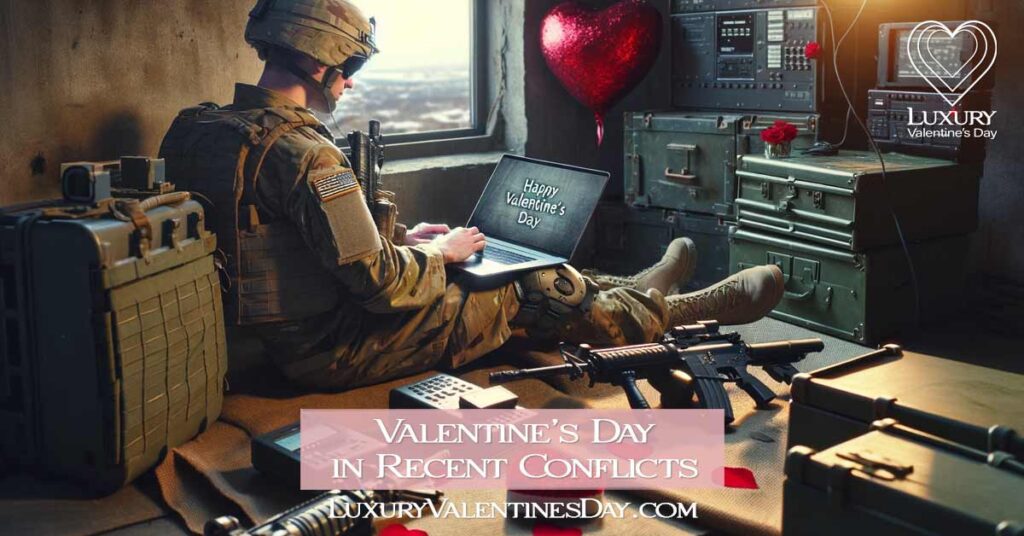
As we move closer to contemporary times, the observance of Valentine’s Day during recent conflicts presents a different yet equally poignant narrative. Modern conflicts, from the Gulf War to the ongoing engagements in the Middle East and other regions, have continued to challenge the ways in which love and affection are expressed during times of war.
The advent of new technologies and communication methods has dramatically altered the dynamic of wartime relationships. Unlike the eras of handwritten letters and postcards, soldiers and their loved ones now often have access to digital communication tools. Emails, instant messaging, and video calls have become the new norm for staying connected. However, the emotional essence of Valentine’s Day remains unchanged – it’s still a day for expressing love and affection, perhaps felt even more deeply in the shadow of conflict.
Digital Expressions of Love
In recent conflicts, the immediacy of digital communication has allowed for more frequent and instant connections. Soldiers can now send electronic Valentine’s Day cards, emails, or even share moments through video chats. While this has made communication easier, the emotional weight carried by each message remains profound.
Challenges of Modern Warfare
Despite these technological advancements, the challenges of distance and the realities of war remain significant. Time zone differences, limited internet access in combat zones, and the ever-present danger create a backdrop where Valentine’s Day messages are a cherished respite, a brief escape into a world of normalcy and love.
Personalized and Creative Gestures
Modern soldiers and their partners often get creative with their Valentine’s gestures. Personalized videos, online playlists, and virtual dates have become part of the new Valentine’s Day tradition for many military couples. These acts of love demonstrate adaptability and resilience, echoing the timeless nature of love through changing times.
Support from Home
Communities and organizations often rally to support troops overseas during Valentine’s Day. Sending care packages, hand-written letters, and organizing events to show love and support for those serving in conflict zones are common practices. These gestures not only boost morale for the soldiers but also strengthen the bonds within the community.
Valentine’s Day in the context of recent conflicts underscores the enduring spirit of love and the human capacity to maintain emotional connections despite the challenges of modern warfare. It reflects the evolving nature of communication and the unchanging essence of the human heart, longing for connection and affection in times of separation and uncertainty.
Valentine’s Day: A Symbol of Hope
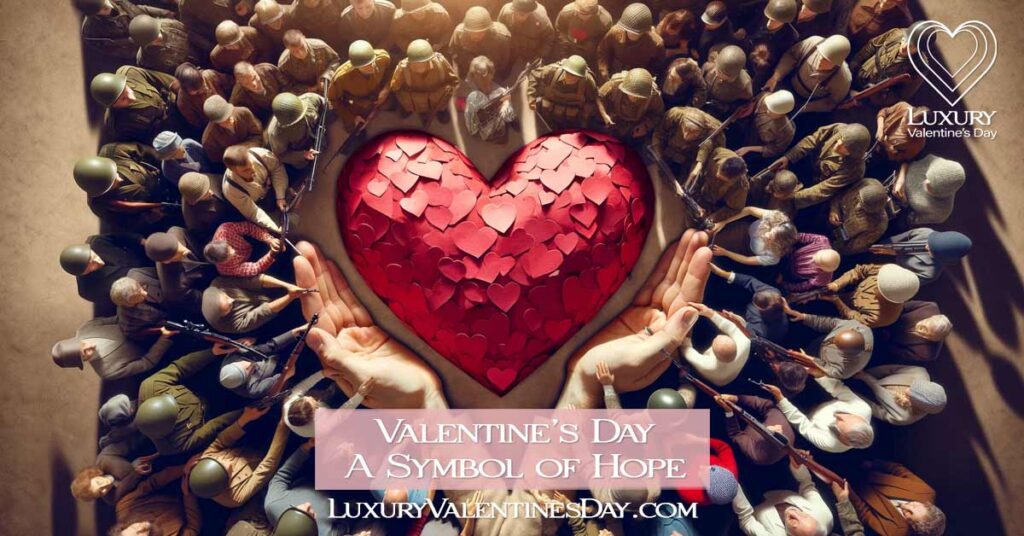
In the tapestry of human experiences, Valentine’s Day has emerged as a symbol of hope, particularly poignant in times of conflict and turmoil. Across different eras, from the American Civil War to contemporary conflicts, this day has consistently offered a glimmer of normalcy, a reminder of the enduring power of love amidst the chaos of war.
Beacon of Normalcy in Chaos
Throughout history, Valentine’s Day has served as a day when the harsh realities of war could be momentarily set aside. Whether through handwritten letters during the Civil War or digital messages in recent conflicts, Valentine’s Day has allowed soldiers and civilians alike to pause and reflect on the personal relationships that provide comfort and strength.
Emotional Respite and Connection
For those separated by war, Valentine’s Day has become an opportunity to reaffirm emotional bonds. It’s a day to express feelings of love and affection, which might otherwise remain unspoken in the daily struggle for survival. This expression of love serves as an emotional anchor, providing both the sender and the recipient with a sense of connection and hope.
Symbol of Resilience and Endurance
The celebration of Valentine’s Day during times of conflict is a testament to the resilience of the human spirit. It demonstrates how love and affection can transcend the barriers of war, distance, and time. The persistent observance of this day highlights the innate human desire for connection and the indomitable spirit of hope that sustains people through difficult times.
Reflection of Cultural and Historical Significance
Valentine’s Day also serves as a reflection of the cultural and historical context in which it is celebrated. Each era’s unique observance of this day provides insight into the societal norms, communication methods, and emotional needs of the time. It’s a day that has adapted to the circumstances of each period, yet retained its core significance as a day of love and hope.
Valentine’s Day, in the context of wartime, becomes more than just a celebration of romantic love. It transforms into a powerful symbol of hope, resilience, and the enduring nature of human connections. It’s a day that reminds us of the capacity for love and compassion even in the darkest of times, offering a beacon of light that guides people through the tumult of conflict and strife.
FAQs : Valentine’s Day During Wartime
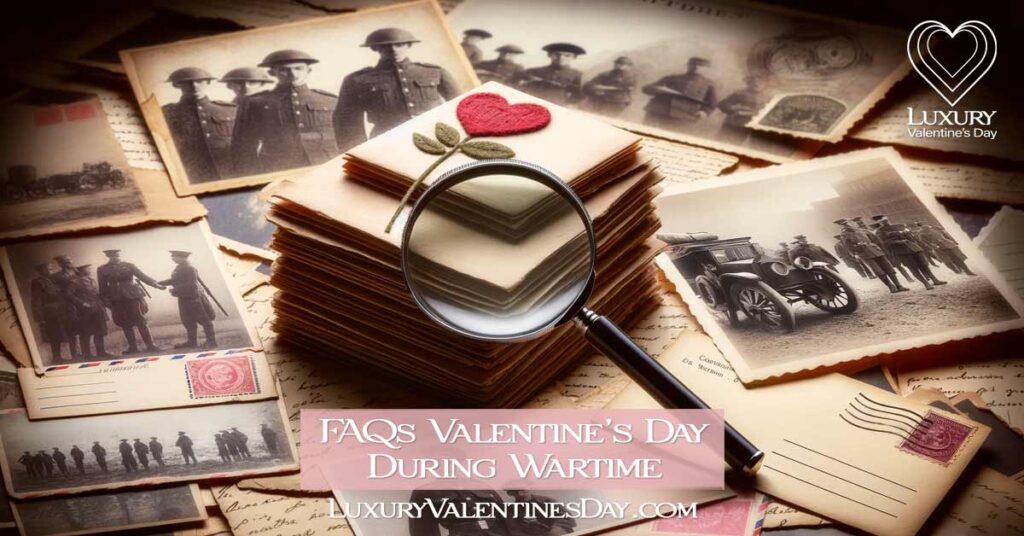
How did soldiers in the Civil War celebrate Valentine’s Day?
During the Civil War, soldiers often celebrated Valentine’s Day by writing heartfelt letters to their loved ones. Due to limited resources, they also made handmade valentines, using whatever materials they had at hand. These tokens of affection were a crucial emotional link between soldiers and their families.
What role did postal services play in wartime Valentine’s exchanges?
Postal services were vital during wartime, especially in World Wars I and II. They facilitated the delivery of letters and postcards, which were the primary means of communication between soldiers and their loved ones. Despite the challenges of war, these services ensured that messages of love and hope reached their destinations.
Are there any famous love stories from these war periods?
Yes, there are many. One notable story is that of Sullivan Ballou, a Civil War soldier, whose poignant love letter to his wife Sarah just before he died in battle remains a testament to enduring love. World War II also had its share of love stories, with countless couples maintaining their relationships through letters and care packages.
How has technology changed the way Valentine’s Day is celebrated during war?
In recent conflicts, technology has significantly changed Valentine’s Day celebrations. Soldiers and their loved ones now use emails, instant messaging, and video calls to stay connected. These digital tools have made communication more immediate, although the emotional significance of the messages remains as profound as ever.
Were there any unique Valentine’s Day traditions during these conflicts?
Yes, each era had its unique traditions. For instance, during World War I, sending decorated postcards became popular, while in World War II, creative use of limited resources led to unique tokens of affection. In modern conflicts, digital messages and virtual celebrations have become more common.
How did societies perceive Valentine’s Day during times of war?
Societies often viewed Valentine’s Day as a welcome distraction from the hardships of war. It was a day to celebrate love and maintain a sense of normalcy. Additionally, it served as a reminder of the human aspects of life, which were especially cherished during such turbulent times.
This FAQ section addresses some of the most common inquiries about Valentine’s Day celebrations during different war periods, offering insights into the historical, emotional, and societal aspects of this enduring tradition.
References
[1] “Roses Have Thorns, Violets Proliferate: Vinegar Valentines During the Civil War” by Meg Groeling, posted on February 13, 2019, on Emerging Civil War: https://emergingcivilwar.com/2019/02/13/roses-have-thorns-violets-proliferate-vinegar-valentines-during-the-civil-war/
[2] “Don’t Forget your Soldier Lovers!” A Story of Civil War Valentines by Angela Esco Elder, February 14, 2019, on The Journal of the Civil War Era: https://www.journalofthecivilwarera.org/2019/02/dont-forget-your-soldier-lovers-a-story-of-civil-war-valentines/
[3] “These Civil War Valentines Are Sour Like Lemons” by Rebecca Onion, February 14, 2018, for Slate: https://slate.com/culture/2018/02/satirical-civil-war-valentines-sent-by-civilians-during-the-conflict.html
[4] “Hearts at War: Valentine’s Day in the Civil War” by Ruth Ann Coski, 5/2/2018, for HistoryNet: https://www.historynet.com/hearts-war-valentines-day-civil-war/
[5] “Civil War Valentines” by Kansas Historical Society, November 1999, for the Kansas Historical Society: https://www.kshs.org/kansapedia/civil-war-valentines/10346
[6] https://www.sydney.edu.au/news-opinion/news/2017/02/06/valentines-day-1917-a-love-letter-on-a-battlefield.html
[7] https://www.itv.com/news/2017-02-14/passion-of-ww1-troops-revealed-in-letters-to-valentines
[8] https://www.redcross.org.uk/stories/our-movement/our-history/valentine-volunteers-love-stories-from-world-war-1
[9] “Make Love AND War? Valentine’s Day During the First World War” by dduquette, 2017, for Steemit.com: https://steemit.com/explore1918/@dduquette/make-love-iand-i-war-valentine-s-day-during-the-first-world-war
[10] “Love Letters of the First World War” by Hayley Rix, 13 February 2015, for First World War Focus and the National Army Museum: https://ww1.nam.ac.uk/1463/news/love-letters-first-world-war/
[11] “Valentine’s Day 1945 – When the Americans bombed Prague” by Thomas McEnchroe for Radio Prague International: https://english.radio.cz/valentines-day-1945-when-americans-bombed-prague-8108050
[12] “Love—Guess Who! Valentine’s Letters from World War II” by Chase Tomlin is an Associate Curator at The National WWII Museum: https://www.nationalww2museum.org/war/articles/valentines-letters-world-war-ii
[13] “‘Dearest Sweetheart’: The passion and poignancy of wartime love letters” by Gillian Brockell, February 14, 2021, for The Washington Post: https://www.washingtonpost.com/history/2021/02/14/war-love-letters-valentines-day/
Related Posts
- Date Ideas That Start with U: Unique and Unforgettable Dates
- Dating Quotes Cute Enough to Make Your Heart Flutter
- Butternut Squash Ravioli with Sage Butter: A Perfect Romantic Dinner for Two
- Alphabet Date Ideas: A to Z Guide for Creative Couples
- Valentine’s Day Bathroom Décor Ideas: Transform Your Space into a Romantic Haven
- Date Ideas That Start with J: Joyful and Jazzy Dates













